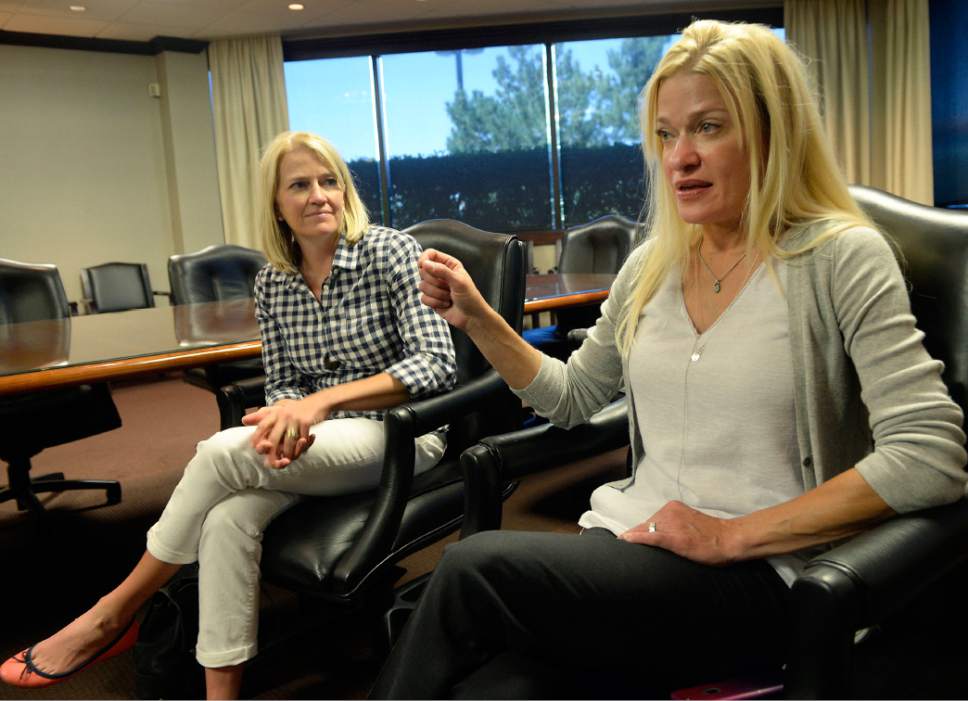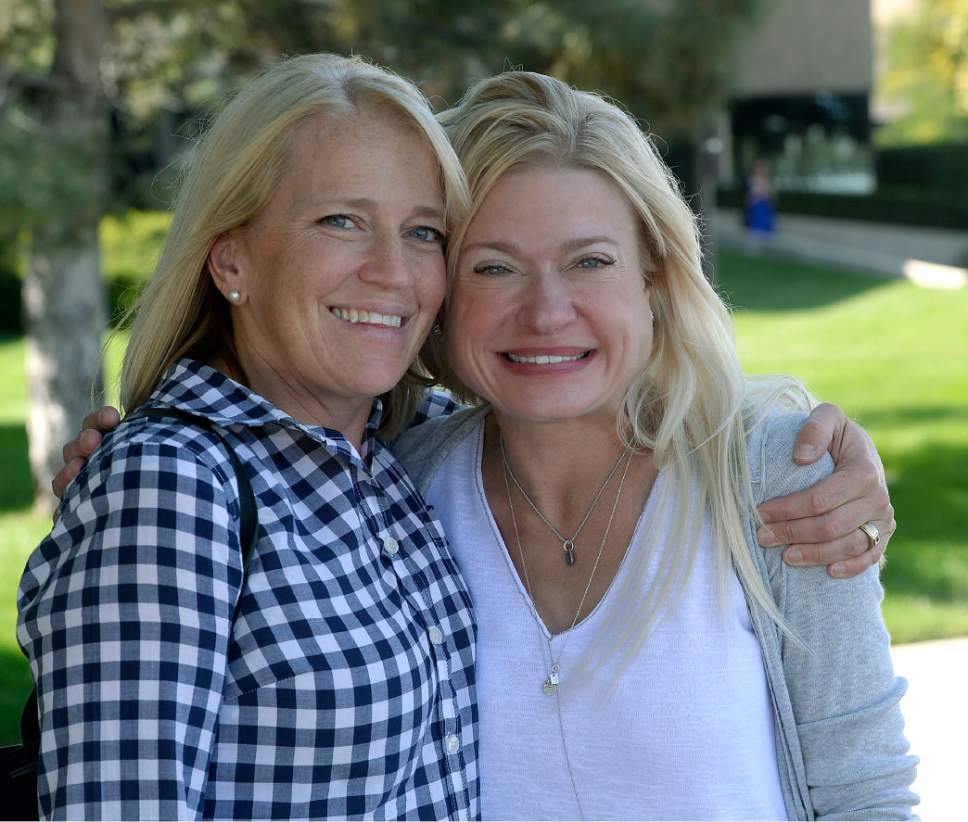This is an archived article that was published on sltrib.com in 2016, and information in the article may be outdated. It is provided only for personal research purposes and may not be reprinted.
Lisa Callister walked into LDS Hospital in 2012 for a routine colonoscopy. She walked out knowing a tumor had been growing unchecked in her colon for about six years.
She battled for more than a year as colon cancer ravaged her body. Doctors had to remove the entire organ.
But the ordeal might have been avoided, Callister said, if she had previously known that she had Lynch Syndrome, an inherited disorder that increases the risk of many cancers. The gene runs in her family, but Callister, her sister, Emily Scalley, and their siblings had not been tested.
Now, the sisters get yearly colonoscopies. They also have their children tested for the gene when they enter their teenage years. So far, two of the six kids between them have the gene.
"We just feel like this knowledge is power and it gives us an edge to be ahead of the game so we don't have to go through what Lisa did," Scalley said.
Callister and Scalley's large, extended family is cataloged in the Utah Population Database, a collection of information — from driver license data to divorce decrees to family histories — on millions of individuals with Utah connections.
People aren't notified in advance when their health records or other personal information are sent to the database — but anyone born in Utah, or who has been treated for a health issue while living here, or has had common interactions with state government, such as voting or registering a marriage, is likely included.
The database of about 8 million individuals is managed by the Huntsman Cancer Institute at the University of Utah and is used for biomedical and health-related research, which has contributed to the discovery of genes that cause breast and colon cancers, for example, as well as genes for cardiac arrhythmia.
Researchers' ability to fill in family histories — and hopefully discover new genes that cause diseases — is about to get even better.
Database staff members are currently inputting an additional 90 million genealogical records for individuals who have some kind of connection to Utah, which will make it more of a worldwide database — making it unlike any other in the world, said Ken Smith, database director.
—
'Unique opportunities' • The U. has been building the database since the 1970s, when researchers started compiling data in an effort to observe patterns in families. Initially, they combined cancer and genealogical records with records from the state Department of Health, Smith said.
But today, researchers have access to much more information. Through agreements with state agencies, Smith said, records in the database include driver licenses, birth and death certificates, marriage licenses and divorce decrees and voter registrations. Some of the records stretch back to the 1800s.
Agreements with University of Utah Health Care and Intermountain Healthcare allow medical information to be linked to other records when a research question requires it. Federal Medicare records can also be linked in this way, Smith said.
Smith added that all these records have been de-identified, with a separate key that allows only the database's operators to link records to specific people.
The U. does not need consent to collect this information, Smith said.
When the database began to take off in the 1980s, Smith said, Utah policymakers, as well as the health and government agencies that were sharing the data, determined that the U. could add records to the database — or use those records for research — without an individual's knowledge because of the "unique opportunities the resource provided for understanding health and disease, and for developing new medical treatments."
At the same time, the Utah Resource for Genetic and Epidemiologic Research was established to govern access to the database. To this day, the U. office, along with an Institutional Review Board, is in charge of approving its use for research purposes.
Michelle De Mooy, acting director for the Center for Democracy and Technology's privacy and data project, notes de-identification of records is less effective "as more and more data is available from lots of different sources." Companies go to great lengths to make sure studies using an individual's information are "opt-in," she said.
"Utah isn't violating the law, but it seems like they're violating a lot of best practices," she said.
But Jorde and Smith stressed that researchers given specific datasets do not have access to individual names or Social Security numbers, for example.
"This is not a trivial undertaking ... we treat it with all seriousness," Smith said. "I think there's so much at stake in terms of medical discoveries, we would never take shortcuts on anything."
All the information is on servers, but Smith said there are many firewalls in place. In its 40 years of existence, Smith said the database has never been hacked.
Smith said people can call the U. to ask that their information not be used in future research. Their existing information is not removed, however.
He said they don't get many of those requests. Most people say, "if my little piece of data can help advance science, then please use it," Smith said.
—
Medical discoveries • The database is "vital," said Lynn Jorde, executive director of the Utah Genome Project, to the work he and his colleagues do at the U.
By linking genealogical data to medical records, the database gives researchers "the ability to say, 'This person in the genealogy was also diagnosed with the disease,'" Jorde said. "It allows us to identify high-risk families."
The Utah Genome Project does DNA sequencing on thousands of people from Utah who have given consent, to find causes for inherited diseases in families. The database also can help develop new treatments and screening procedures.
If a researcher wanted to conduct a study on Lynch Syndrome, for example, Callister's and Scalley's family would come up in the database — de-identified, of course. Researchers can then work with database's operators to contact an individual's physician about an opportunity to participate a clinical trial or study.
They also work through physicians to determine whether patients want to know if they have a cancer gene, for example. Some people don't want to know — family history can be very sensitive information, Jorde said.
But Callister and Scalley think the database, and the knowledge it can bring families, is great. "The database can help families," Callister said. "It can spare them a lot of pain and suffering."
There are more than 200 research projects currently being conducted using the database, Smith said.
Using the population database, researchers have discovered genes that cause breast and ovarian cancer, as well as melanoma. Smith said driver license information — height, weight and addresses — has been used to determine areas with the highest obesity rates.
Researchers have used it to look at preterm birth, Lou Gehrig's Disease and pediatric cancers, Jorde said. There's an autism study that's been going on for several decades, he added.
—
90 million more • The 90 million genealogical records being added "will really fill in some of the families because, of course, people move out of the state or have family members who do," Jorde said. "So, those people are kind of lost and this should help build those families up."
Smith said these connections can be incredibly remote. Someone in Utah might be related to someone in Missouri, for example, through a member of French royalty in the 1600s, he said.
But if the database can help trace the mutation of some form of cancer back to a single individual, people all over the country — and the world — related to that person could have better information about their cancer risk.
To truly make it a worldwide database, Smith said, the U. would need agreements with medical centers around the globe to access their records.
That thought might freak some people out, Callister and Scalley said. But the connections could be invaluable, they added, noting that knowing they have Lynch Syndrome allows them to take preventive steps against cancer.
Their yearly colonoscopies are "just like a dental cleaning," Scalley said. "They find polyps in me every year, so at least they're cutting out what could turn into cancer."









